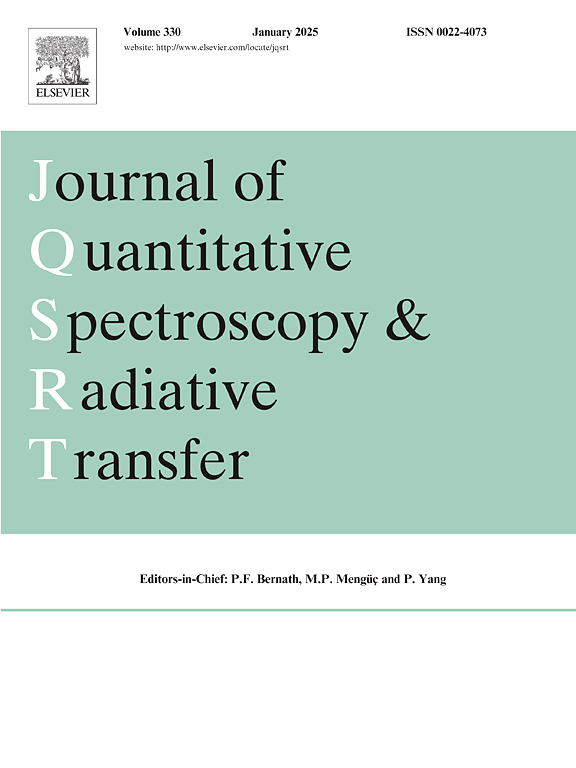Measurement of circular intensity differential scattering (CIDS) from single optically trapped biological particles
IF 2.3
3区 物理与天体物理
Q2 OPTICS
Journal of Quantitative Spectroscopy & Radiative Transfer
Pub Date : 2024-11-01
DOI:10.1016/j.jqsrt.2024.109244
引用次数: 0
Abstract
The circular intensity differential scattering (CIDS), which is the normalized Mueller matrix element -S14/S11, has been measured from single biological particles as a function of scattering angle. CIDS is valuable for its potential in detecting chiral particles that may include the helical structures of DNA or RNA molecules in biological samples, and as such is a potential method for detecting biological particles. Optical trapping is employed to levitate single particles within a custom-designed elliptical reflector for CIDS measurements. The advantage of optical levitation in light-scattering measurements is that single particles can be suspended in air with sufficient working distance to prevent interference from the suspending apparatus. To measure the phase function, the reflector is used to collect the angle-dependent scattering signals. We demonstrated that we can obtain two-dimensional angular optical scattering (TAOS) patterns that cover a wide angular range from single levitated particles. These TAOS patterns are generated using 532 nm illumination of left-handed and right-handed circular polarizations and recorded from trapped single particles (silica, English Oak, Ragweed, Mulberry, Glycine, and l-Aspartic acid).
测量单个光学捕获生物颗粒的圆强度微分散射(CIDS)
圆强度微分散射(CIDS)是穆勒矩阵元素 -S14/S11 的归一化,它是根据散射角的函数从单个生物颗粒中测量出来的。CIDS 在检测生物样本中可能包括 DNA 或 RNA 分子螺旋结构的手性粒子方面具有重要价值,因此是检测生物粒子的一种潜在方法。光学捕集技术可将单个粒子悬浮在定制的椭圆形反射镜中,用于 CIDS 测量。在光散射测量中,光学悬浮的优势在于单个粒子可以悬浮在空气中,并有足够的工作距离来防止悬浮装置的干扰。为了测量相位函数,反射器用于收集随角度变化的散射信号。我们已经证明,我们可以从单个悬浮粒子上获得覆盖很宽角度范围的二维角光散射(TAOS)图案。这些二维角光散射图样是使用 532 nm 波长的左旋和右旋圆偏振光照明产生的,并记录了被困的单个颗粒(二氧化硅、英国橡树、豚草、桑树、甘氨酸和 l-天门冬氨酸)。
本文章由计算机程序翻译,如有差异,请以英文原文为准。
求助全文
约1分钟内获得全文
求助全文
来源期刊
CiteScore
5.30
自引率
21.70%
发文量
273
审稿时长
58 days
期刊介绍:
Papers with the following subject areas are suitable for publication in the Journal of Quantitative Spectroscopy and Radiative Transfer:
- Theoretical and experimental aspects of the spectra of atoms, molecules, ions, and plasmas.
- Spectral lineshape studies including models and computational algorithms.
- Atmospheric spectroscopy.
- Theoretical and experimental aspects of light scattering.
- Application of light scattering in particle characterization and remote sensing.
- Application of light scattering in biological sciences and medicine.
- Radiative transfer in absorbing, emitting, and scattering media.
- Radiative transfer in stochastic media.

 求助内容:
求助内容: 应助结果提醒方式:
应助结果提醒方式:


